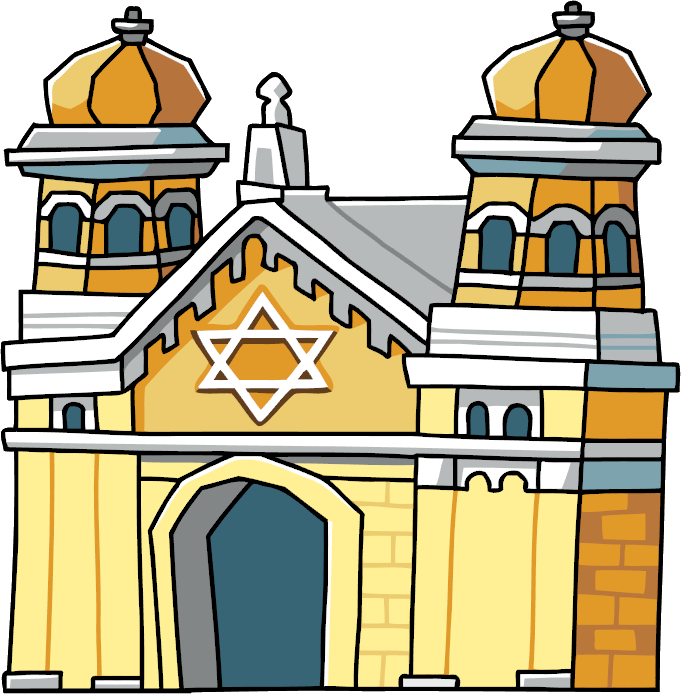
This image has format transparent PNG with resolution 681x694.
You can download this image in best resolution from this page and use it for design and web design.
Synagogue PNG with transparent background you can download for free, just click on download button.
A synagogue, also spelled synagog is a Jewish or Samaritan house of worship.
Synagogues have a large place for prayer (the main sanctuary) and may also have smaller rooms for study and sometimes a social hall and offices. Some have a separate room for Torah study, called the beth midrash "house of study".
Synagogues are consecrated spaces used for the purpose of prayer, Tanakh (the entire Hebrew Bible, including the Torah) reading, study and assembly; however, a synagogue is not necessary for worship. Halakha holds that communal Jewish worship can be carried out wherever ten Jews (a minyan) assemble. Worship can also be carried out alone or with fewer than ten people assembled together. However, halakha considers certain prayers as communal prayers and therefore they may be recited only by a minyan. In terms of its specific ritual and liturgical functions, the synagogue does not replace the long-since destroyed Temple in Jerusalem.
Although synagogues existed a long time before the destruction of the Second Temple in 70 CE, communal worship in the time while the Temple still stood centered around the korbanot ("sacrificial offerings") brought by the kohanim ("priests") in the Temple in Jerusalem. The all-day Yom Kippur service, in fact, was an event in which the congregation both observed the movements of the kohen gadol ("the high priest") as he offered the day's sacrifices and prayed for his success.
During the Babylonian captivity (586–537 BCE) the men of the Great Assembly formalized and standardized the language of the Jewish prayers. Prior to that people prayed as they saw fit, with each individual praying in his or her own way, and there were no standard prayers that were recited.
Johanan ben Zakai, one of the leaders at the end of the Second Temple era, promulgated the idea of creating individual houses of worship in whatever locale Jews found themselves. This contributed to the continuity of the Jewish people by maintaining a unique identity and a portable way of worship despite the destruction of the Temple, according to many historians.
Synagogues in the sense of purpose-built spaces for worship, or rooms originally constructed for some other purpose but reserved for formal, communal prayer, however, existed long before the destruction of the Second Temple. The earliest archaeological evidence for the existence of very early synagogues comes from Egypt, where stone synagogue dedication inscriptions dating from the 3rd century BCE prove that synagogues existed by that date. More than a dozen Jewish (and possibly Samaritan) Second Temple era synagogues have been identified by archaeologists in Palestine and other countries belonging to the Hellenistic world.
Any Jew or group of Jews can build a synagogue. Synagogues have been constructed by ancient Jewish kings, by wealthy patrons, as part of a wide range of human institutions including secular educational institutions, governments, and hotels, by the entire community of Jews living in a particular place, or by sub-groups of Jews arrayed according to occupation, ethnicity (i.e. the Sephardic, Polish or Persian Jews of a town), style of religious observance (i.e., a Reform or an Orthodox synagogue), or by the followers of a particular rabbi.
It has been theorized that the synagogue became a place of worship in Palestine upon the destruction of the Second Temple during the First Jewish–Roman War; however, others speculate that there had been places of prayer, apart from the Temple, during the Hellenistic period. The popularization of prayer over sacrifice during the years prior to the destruction of the Second Temple in 70 CE had prepared the Jews for life in the diaspora, where prayer would serve as the focus of Jewish worship.
Despite the possibility of synagogue-like spaces prior to the First Jewish–Roman War, the synagogue emerged as a stronghold for Jewish worship upon the destruction of the Temple. For Jews living in the wake of the Revolt, the synagogue functioned as a "portable system of worship". Within the synagogue, Jews worshipped by way of prayer rather than sacrifices, which had previously served as the main form of worship within the Second Temple.
In this page you can download free PNG images: Synagogue PNG images free download